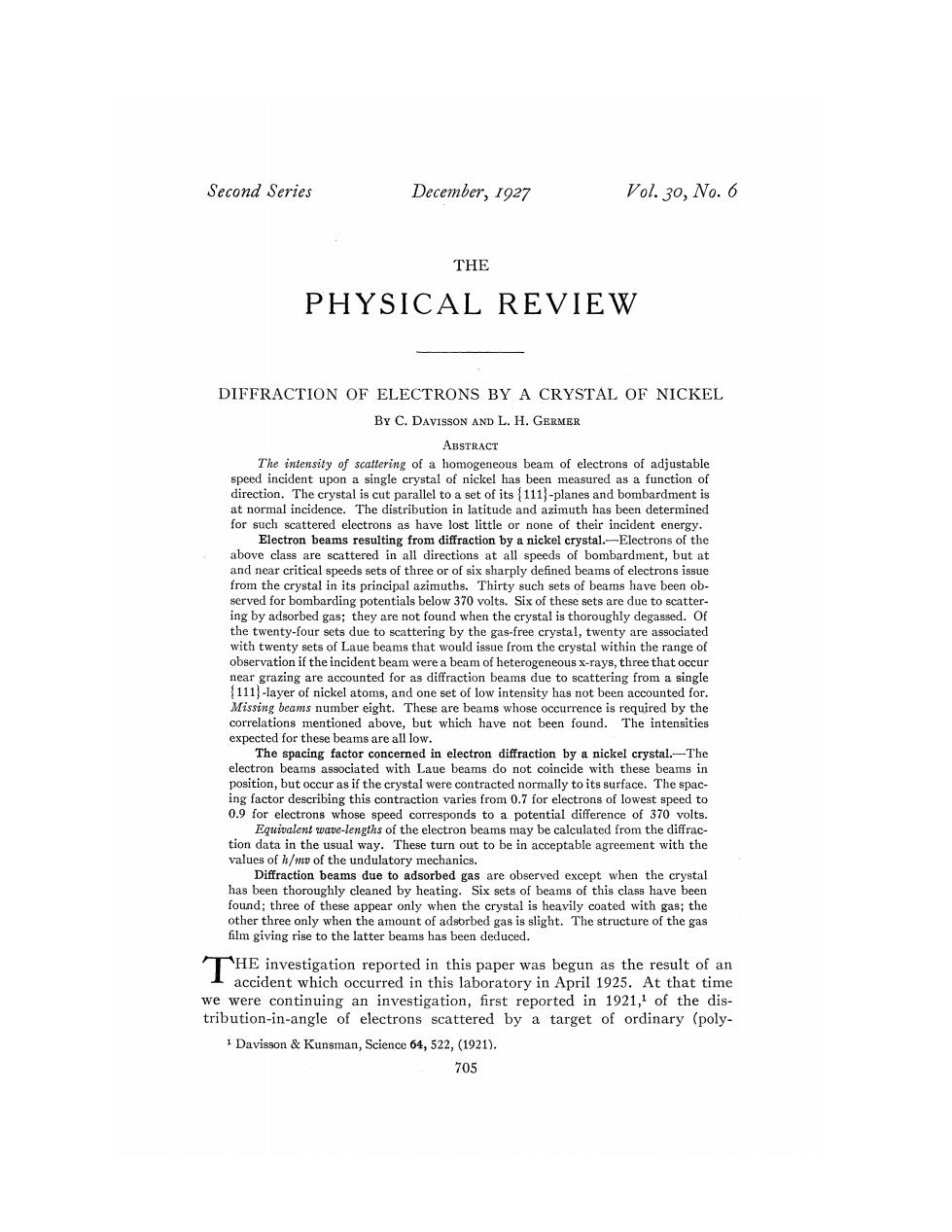
Second Series December,1927 'ol.30,No.6 THE PHYSICAL REVIEW DIFFRACTION OF ELECTRONS BY A CRYSTAL OF NICKEL BY C.DAVISSON AND L.H.GERMER ABSTRACT The intensity of scattering of a homogeneous beam of electrons of adjustable speed incident upon a single crystal of nickel has been measured as a function of direction.The crystal is cut parallel to a set of its111-planes and bombardment is at normal incidence.The distribution in latitude and azimuth has been determined for such scattered electrons as have lost little or none of their incident energy. Electron beams resulting from diffraction by a nickel crystal.-Electrons of the above class are scattered in all directions at all speeds of bombardment,but at and near critical speeds sets of three or of six sharply defined beams of electrons issue from the crystal in its principal azimuths.Thirty such sets of beams have been ob- served for bombarding potentials below 370 volts.Six of these sets are due to scatter- ing by adsorbed gas;they are not found when the crystal is thoroughly degassed.Of the twenty-four sets due to scattering by the gas-free crystal,twenty are associated with twenty sets of Laue beams that would issue from the crystal within the range of observation if the incident beam were a beam of heterogeneous x-rays,three that occur near grazing are accounted for as diffraction beams due to scattering from a single 111-layer of nickel atoms,and one set of low intensity has not been accounted for. Missing beams number eight.These are beams whose occurrence is required by the correlations mentioned above,but which have not been found.The intensities expected for these beams are all low. The spacing factor concerned in electron diffraction by a nickel crystal.-The electron beams associated with Laue beams do not coincide with these beams in position,but occur as if the crystal were contracted normally to its surface.The spac- ing factor describing this contraction varies from 0.7 for electrons of lowest speed to 0.9 for electrons whose speed corresponds to a potential difference of 370 volts. Eguivalent wave-lengths of the electron beams may be calculated from the diffrac- tion data in the usual way.These turn out to be in acceptable agreement with the values of h/mn of the undulatory mechanics. Diffraction beams due to adsorbed gas are observed except when the crystal has been thoroughly cleaned by heating.Six sets of beams of this class have been found;three of these appear only when the crystal is heavily coated with gas;the other three only when the amount of adsorbed gas is slight.The structure of the gas film giving rise to the latter beams has been deduced. HE investigation reported in this paper was begun as the result of an accident which occurred in this laboratory in April 1925.At that time we were continuing an investigation,first reported in 1921,1 of the dis- tribution-in-angle of electrons scattered by a target of ordinary (poly- 1 Davisson Kunsman,Science 64,522,(1921). 705
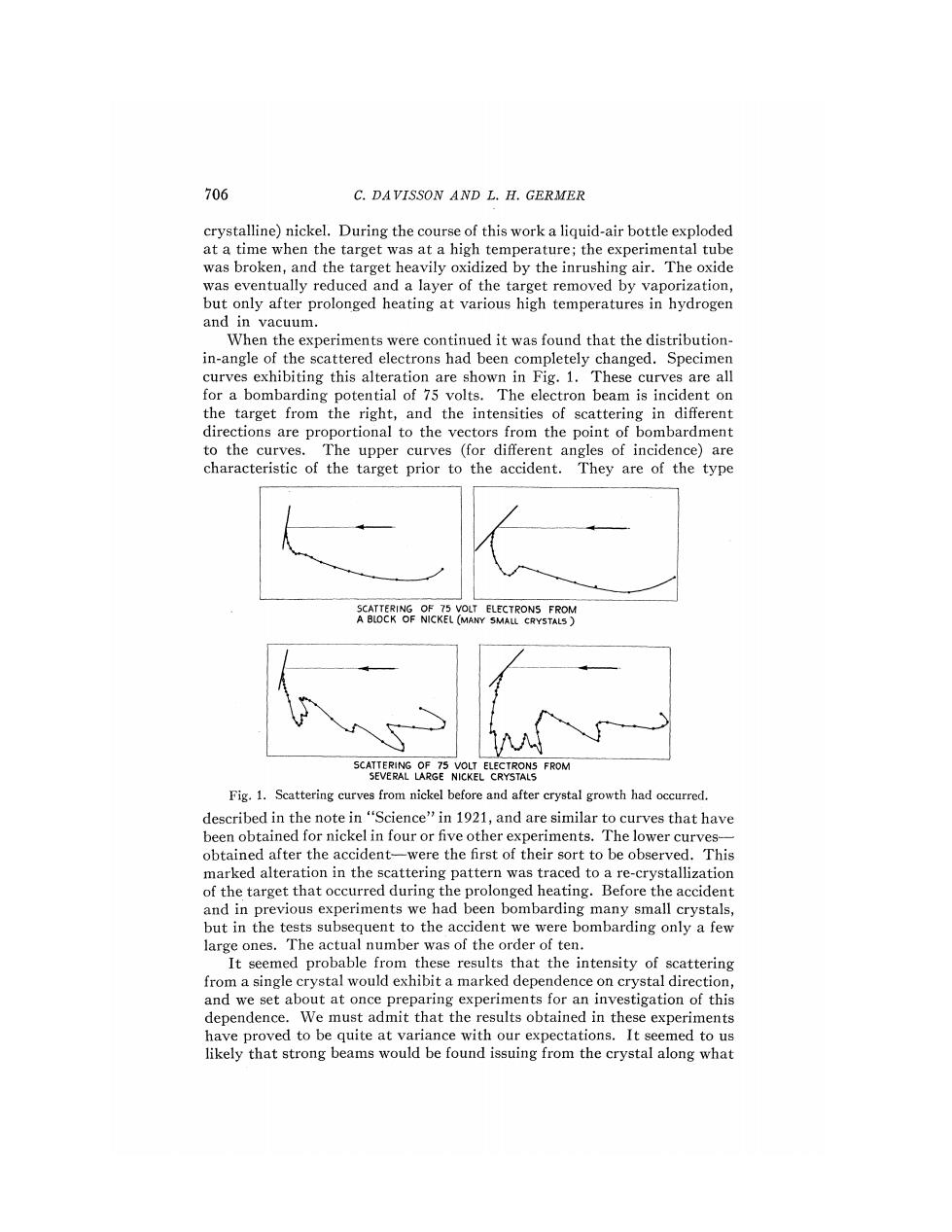
706 C.DAVISSON AND L.H.GERMER crystalline)nickel.During the course of this work a liquid-air bottle exploded at a time when the target was at a high temperature;the experimental tube was broken,and the target heavily oxidized by the inrushing air.The oxide was eventually reduced and a layer of the target removed by vaporization, but only after prolonged heating at various high temperatures in hydrogen and in vacuum. When the experiments were continued it was found that the distribution- in-angle of the scattered electrons had been completely changed.Specimen curves exhibiting this alteration are shown in Fig.1.These curves are all for a bombarding potential of 75 volts.The electron beam is incident on the target from the right,and the intensities of scattering in different directions are proportional to the vectors from the point of bombardment to the curves.The upper curves (for different angles of incidence)are characteristic of the target prior to the accident.They are of the type SCATTERING OF 75 VOLT ELECTRONS FROM A BLOCK OF NICKEL (MANY SMALL CRYSTALS SCATTERING OF 75 VOLT ELECTRONS FROM SEVERAL LARGE NICKEL CRYSTALS Fig.1.Scattering curves from nickel before and after crystal growth had occurred. described in the note in"Science"in 1921,and are similar to curves that have been obtained for nickel in four or five other experiments.The lower curves- obtained after the accident-were the first of their sort to be observed.This marked alteration in the scattering pattern was traced to a re-crystallization of the target that occurred during the prolonged heating.Before the accident and in previous experiments we had been bombarding many small crystals, but in the tests subsequent to the accident we were bombarding only a few large ones.The actual number was of the order of ten. It seemed probable from these results that the intensity of scattering from a single crystal would exhibit a marked dependence on crystal direction, and we set about at once preparing experiments for an investigation of this dependence.We must admit that the results obtained in these experiments have proved to be quite at variance with our expectations.It seemed to us likely that strong beams would be found issuing from the crystal along what
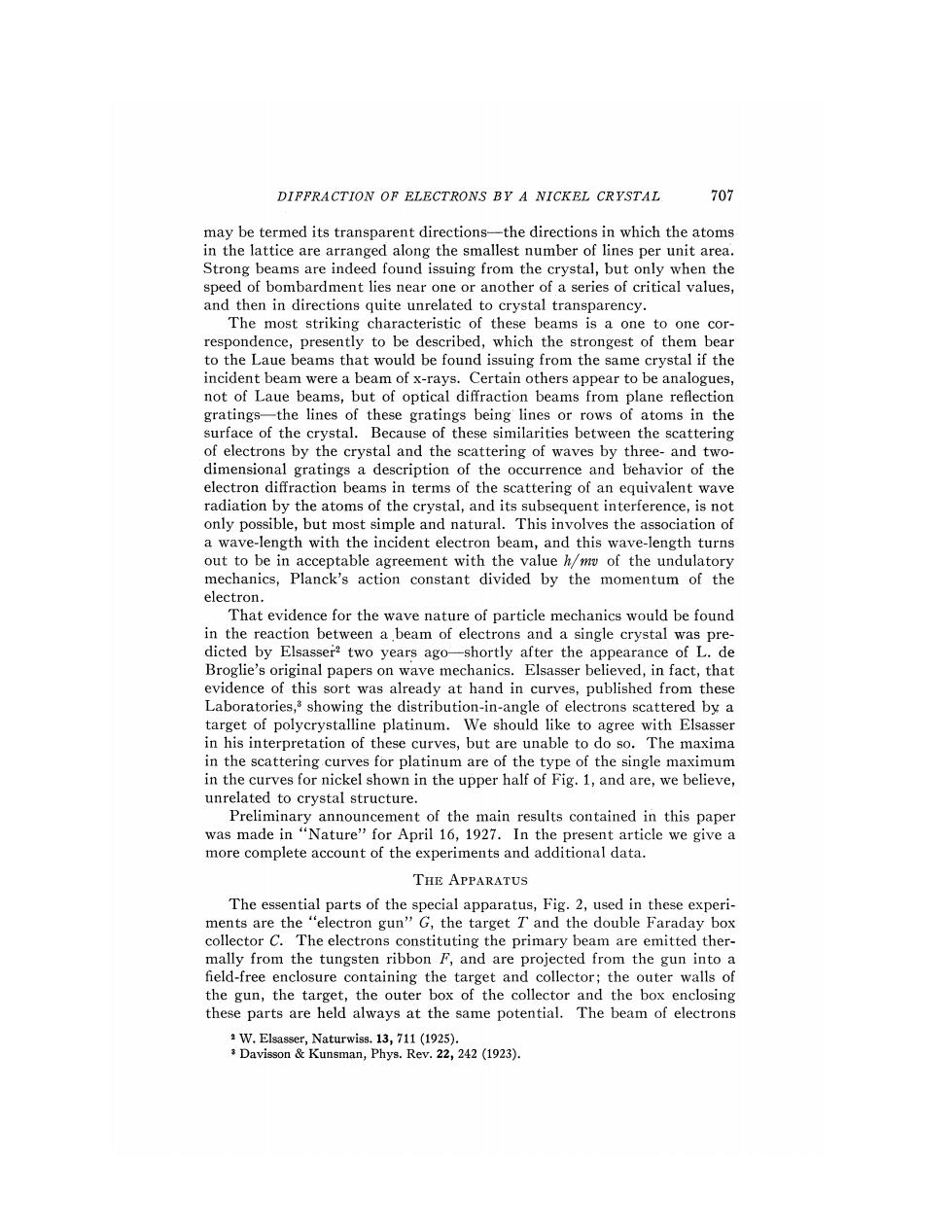
DIFFRACTION OF ELECTRONS BY A NICKEL CRYSTAL 707 may be termed its transparent directions-the directions in which the atoms in the lattice are arranged along the smallest number of lines per unit area. Strong beams are indeed found issuing from the crystal,but only when the speed of bombardment lies near one or another of a series of critical values, and then in directions quite unrelated to crystal transparency. The most striking characteristic of these beams is a one to one cor- respondence,presently to be described,which the strongest of them bear to the Laue beams that would be found issuing from the same crystal if the incident beam were a beam of x-rays.Certain others appear to be analogues, not of Laue beams,but of optical diffraction beams from plane reflection gratings-the lines of these gratings being lines or rows of atoms in the surface of the crystal.Because of these similarities between the scattering of electrons by the crystal and the scattering of waves by three-and two- dimensional gratings a description of the occurrence and behavior of the electron diffraction beams in terms of the scattering of an equivalent wave radiation by the atoms of the crystal,and its subsequent interference,is not only possible,but most simple and natural.This involves the association of a wave-length with the incident electron beam,and this wave-length turns out to be in acceptable agreement with the value h/mn of the undulatory mechanics,Planck's action constant divided by the momentum of the electron. That evidence for the wave nature of particle mechanics would be found in the reaction between a beam of electrons and a single crystal was pre- dicted by Elsasser2 two years ago-shortly after the appearance of L.de Broglie's original papers on wave mechanics.Elsasser believed,in fact,that evidence of this sort was already at hand in curves,published from these Laboratories,3 showing the distribution-in-angle of electrons scattered by a target of polycrystalline platinum.We should like to agree with Elsasser in his interpretation of these curves,but are unable to do so.The maxima in the scattering curves for platinum are of the type of the single maximum in the curves for nickel shown in the upper half of Fig.1,and are,we believe, unrelated to crystal structure. Preliminary announcement of the main results contained in this paper was made in "Nature"'for April 16,1927.In the present article we give a more complete account of the experiments and additional data. THE APPARATUS The essential parts of the special apparatus,Fig.2,used in these experi- ments are the"electron gun'G,the target T and the double Faraday box collector C.The electrons constituting the primary beam are emitted ther- mally from the tungsten ribbon f,and are projected from the gun into a field-free enclosure containing the target and collector;the outer walls of the gun,the target,the outer box of the collector and the box enclosing these parts are held always at the same potential.The beam of electrons 2 W.Elsasser,Naturwiss.13,711 (1925). Davisson Kunsman,Phys.Rev.22,242 (1923)
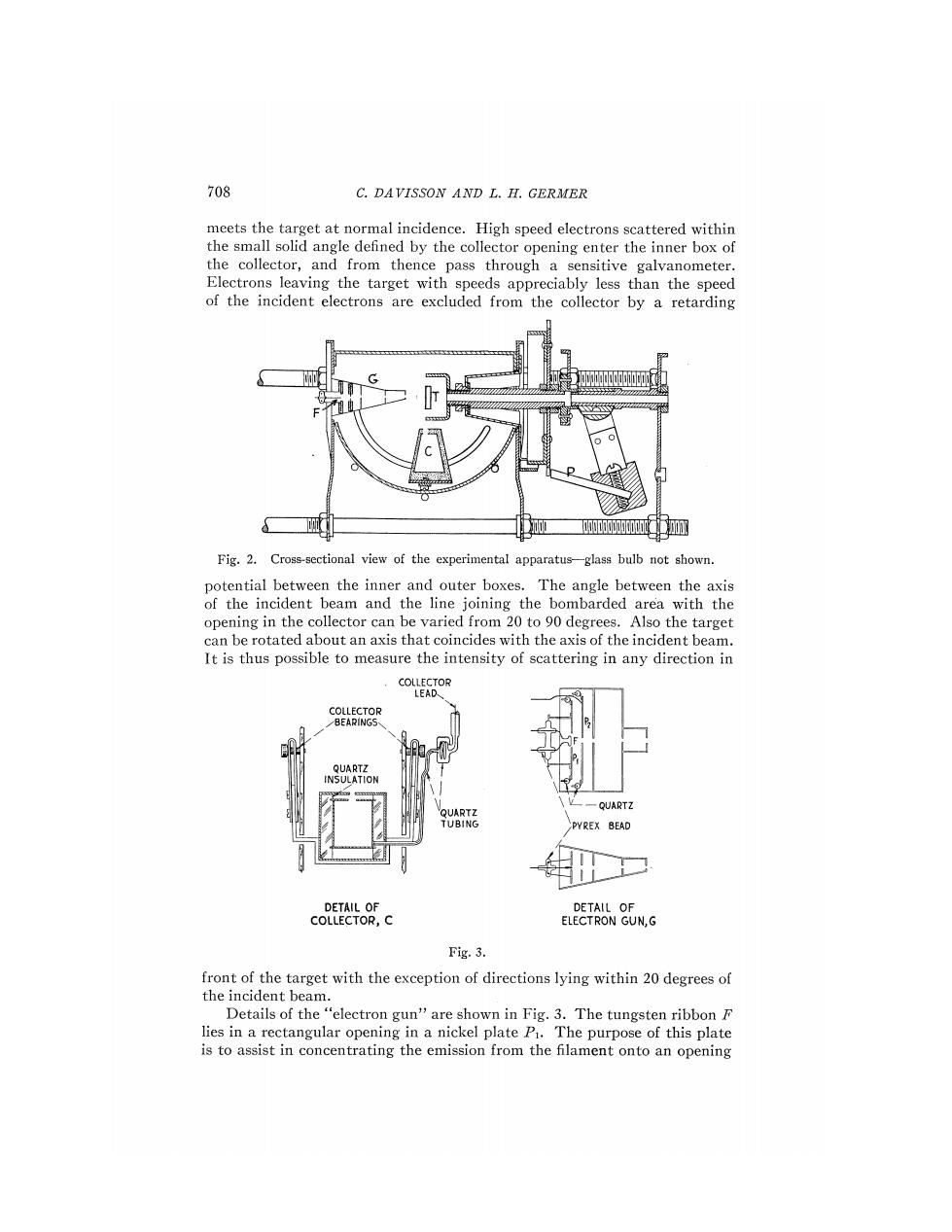
708 C.DAVISSON AND L.H.GERMER meets the target at normal incidence.High speed electrons scattered within the small solid angle defined by the collector opening enter the inner box of the collector,and from thence pass through a sensitive galvanometer. Electrons leaving the target with speeds appreciably less than the speed of the incident electrons are excluded from the collector by a retarding 000007000t00 Fig.2.Cross-sectional view of the experimental apparatus-glass bulb not shown. potential between the inner and outer boxes.The angle between the axis of the incident beam and the line joining the bombarded area with the opening in the collector can be varied from 20 to 90 degrees.Also the target can be rotated about an axis that coincides with the axis of the incident beam. It is thus possible to measure the intensity of scattering in any direction in COLLECTOR LEAD COLLECTOR BEARINGS QUARTZ INSULATION QUARTZ 一QUARTZ TUBING PYREX BEAD DETAIL OF DETAIL OF COLLECTOR,C ELECTRON GUN,G Fig.3. front of the target with the exception of directions lying within 20 degrees of the incident beam. Details of the"electron gun'are shown in Fig.3.The tungsten ribbon F lies in a rectangular opening in a nickel plate P.The purpose of this plate is to assist in concentrating the emission from the filament onto an opening
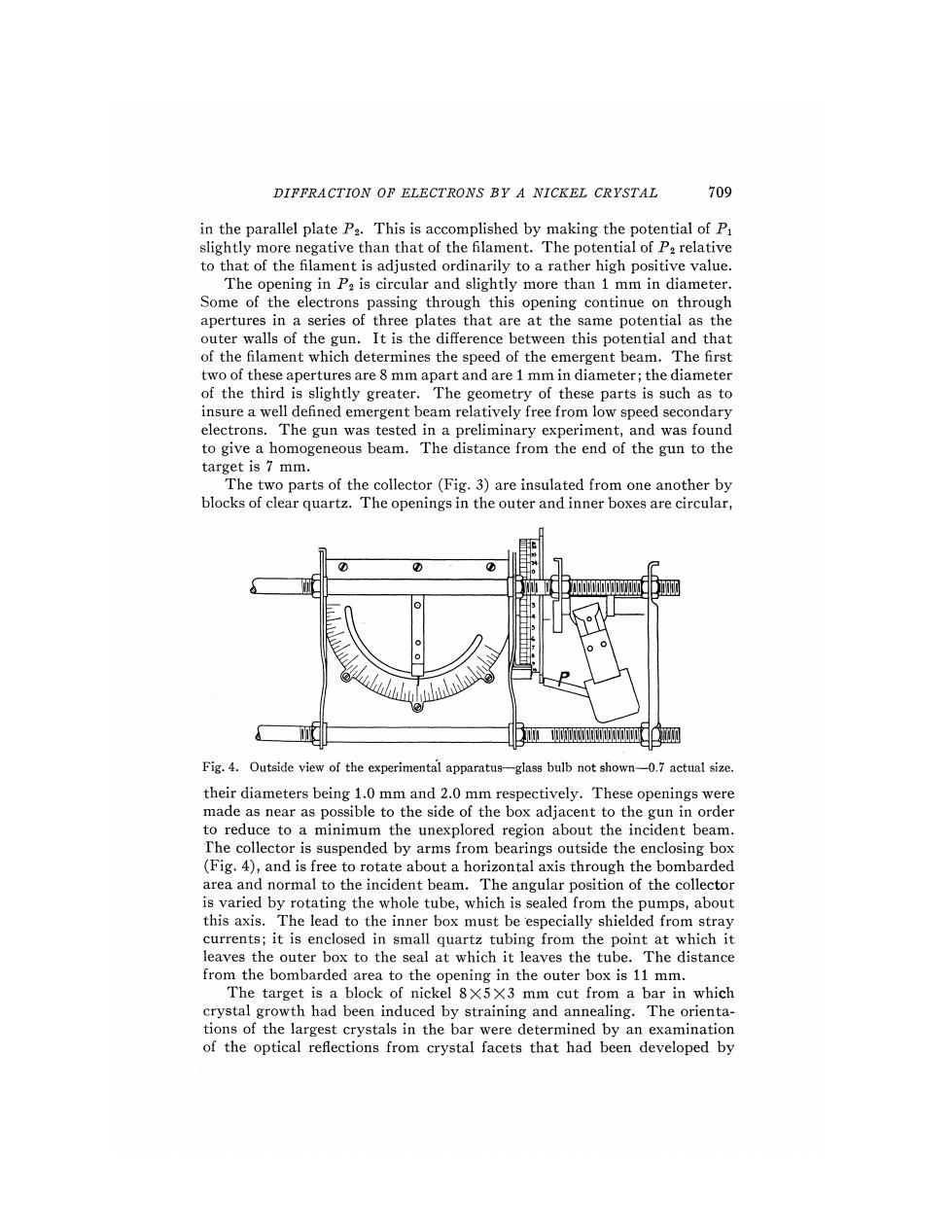
DIFFRACTION OF ELECTRONS BY A NICKEL CRYSTAL 709 in the parallel plate P2.This is accomplished by making the potential of Pi slightly more negative than that of the filament.The potential of P2 relative to that of the filament is adjusted ordinarily to a rather high positive value. The opening in P2 is circular and slightly more than 1 mm in diameter Some of the electrons passing through this opening continue on through apertures in a series of three plates that are at the same potential as the outer walls of the gun.It is the difference between this potential and that of the filament which determines the speed of the emergent beam.The first two of these apertures are 8 mm apart and are 1 mm in diameter;the diameter of the third is slightly greater.The geometry of these parts is such as to insure a well defined emergent beam relatively free from low speed secondary electrons.The gun was tested in a preliminary experiment,and was found to give a homogeneous beam.The distance from the end of the gun to the target is 7 mm. The two parts of the collector (Fig.3)are insulated from one another by blocks of clear quartz.The openings in the outer and inner boxes are circular, Fig.4.Outside view of the experimental apparatus-glass bulb not shown-0.7 actual size. their diameters being 1.0 mm and 2.0 mm respectively.These openings were made as near as possible to the side of the box adjacent to the gun in order to reduce to a minimum the unexplored region about the incident beam. The collector is suspended by arms from bearings outside the enclosing box (Fig.4),and is free to rotate about a horizontal axis through the bombarded area and normal to the incident beam.The angular position of the collector is varied by rotating the whole tube,which is sealed from the pumps,about this axis.The lead to the inner box must be especially shielded from stray currents;it is enclosed in small quartz tubing from the point at which it leaves the outer box to the seal at which it leaves the tube.The distance from the bombarded area to the opening in the outer box is 11 mm. The target is a block of nickel 8x5X3 mm cut from a bar in which crystal growth had been induced by straining and annealing.The orienta- tions of the largest crystals in the bar were determined by an examination of the optical reflections from crystal facets that had been developed by
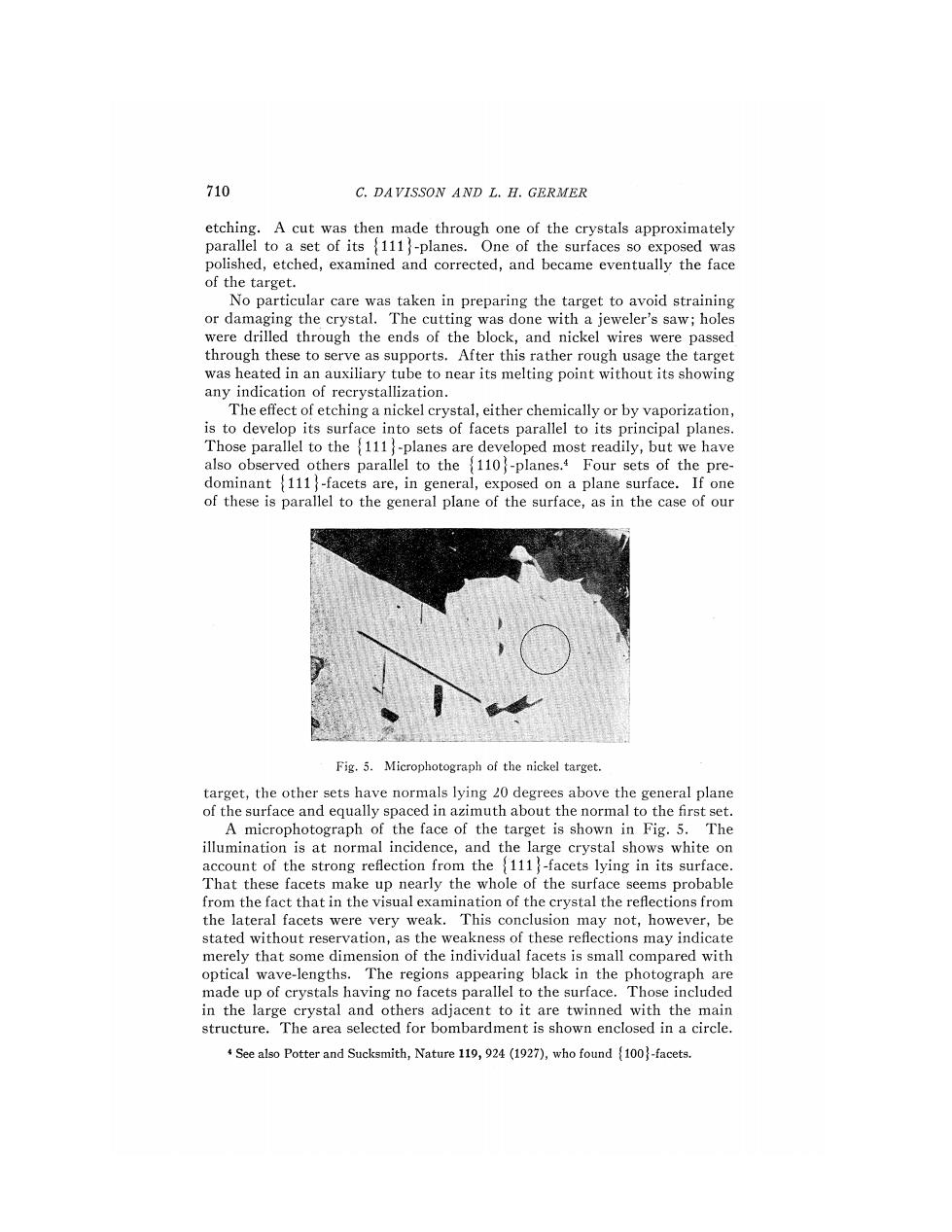
710 C.DAVISSON AND L.H.GERMER etching.A cut was then made through one of the crystals approximately parallel to a set of its 111-planes.One of the surfaces so exposed was polished,etched,examined and corrected,and became eventually the face of the target. No particular care was taken in preparing the target to avoid straining or damaging the crystal.The cutting was done with a jeweler's saw;holes were drilled through the ends of the block,and nickel wires were passed through these to serve as supports.After this rather rough usage the target was heated in an auxiliary tube to near its melting point without its showing any indication of recrystallization. The effect of etching a nickel crystal,either chemically or by vaporization, is to develop its surface into sets of facets parallel to its principal planes. Those parallel to the 111-planes are developed most readily,but we have also observed others parallel to the 110-planes.4 Four sets of the pre- dominant 111-facets are,in general,exposed on a plane surface.If one of these is parallel to the general plane of the surface,as in the case of our Fig.5.Microphotograph of the nickel target. target,the other sets have normals lying 20 degrees above the general plane of the surface and equally spaced in azimuth about the normal to the first set. A microphotograph of the face of the target is shown in Fig.5.The illumination is at normal incidence,and the large crystal shows white on account of the strong reflection from the 111-facets lying in its surface. That these facets make up nearly the whole of the surface seems probable from the fact that in the visual examination of the crystal the reflections from the lateral facets were very weak.This conclusion may not,however,be stated without reservation,as the weakness of these refections may indicate merely that some dimension of the individual facets is small compared with optical wave-lengths.The regions appearing black in the photograph are made up of crystals having no facets parallel to the surface.Those included in the large crystal and others adjacent to it are twinned with the main structure.The area selected for bombardment is shown enclosed in a circle. See also Potter and Sucksmith,Nature 119,924(1927),who found 100)-facets
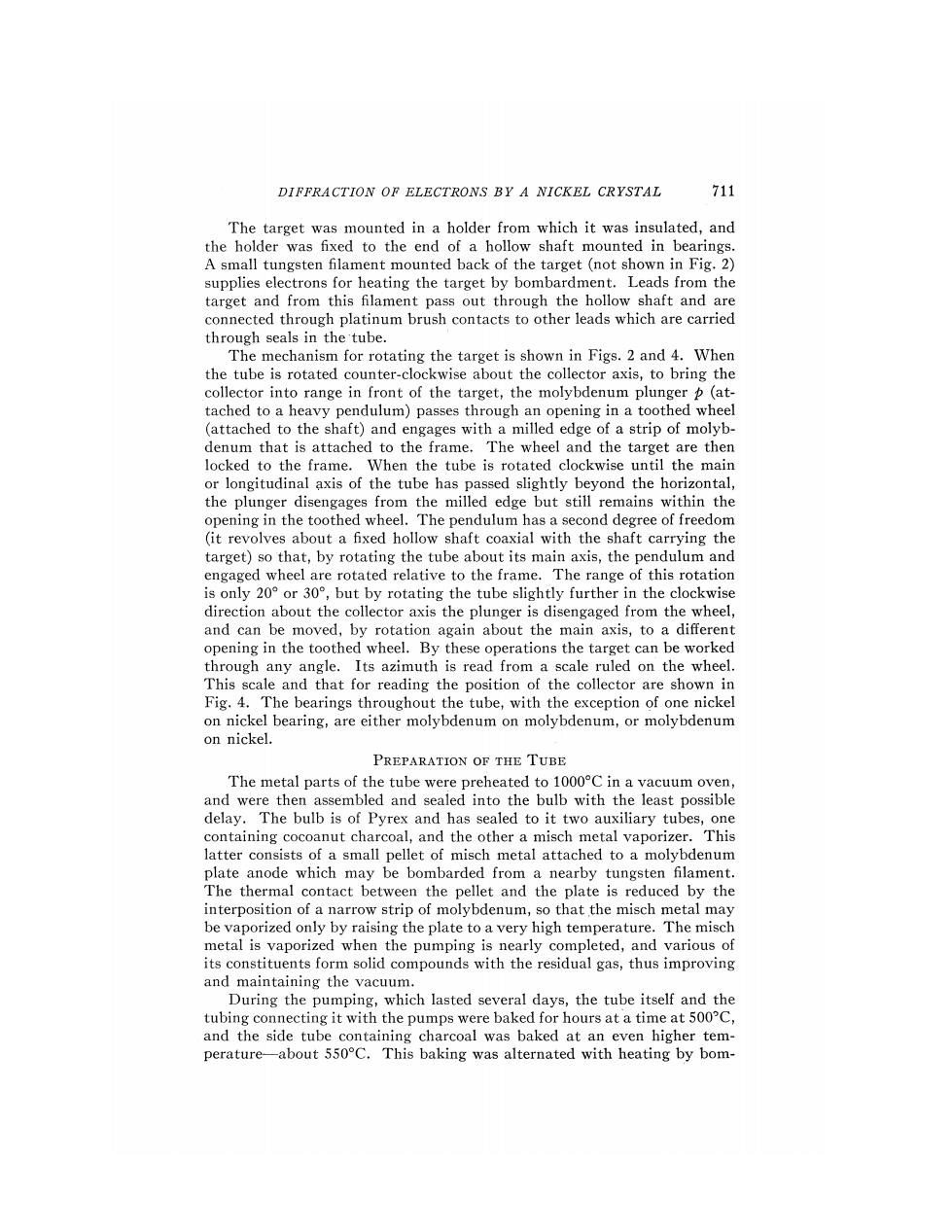
DIFFRACTION OF ELECTRONS BY A NICKEL CRYSTAL 711 The target was mounted in a holder from which it was insulated,and the holder was fixed to the end of a hollow shaft mounted in bearings A small tungsten filament mounted back of the target(not shown in Fig.2) supplies electrons for heating the target by bombardment.Leads from the target and from this filament pass out through the hollow shaft and are connected through platinum brush contacts to other leads which are carried through seals in the tube. The mechanism for rotating the target is shown in Figs.2 and 4.When the tube is rotated counter-clockwise about the collector axis,to bring the collector into range in front of the target,the molybdenum plunger p(at- tached to a heavy pendulum)passes through an opening in a toothed wheel (attached to the shaft)and engages with a milled edge of a strip of molyb- denum that is attached to the frame.The wheel and the target are then locked to the frame.When the tube is rotated clockwise until the main or longitudinal axis of the tube has passed slightly beyond the horizontal, the plunger disengages from the milled edge but still remains within the opening in the toothed wheel.The pendulum has a second degree of freedom (it revolves about a fixed hollow shaft coaxial with the shaft carrying the target)so that,by rotating the tube about its main axis,the pendulum and engaged wheel are rotated relative to the frame.The range of this rotation is only 20 or 30,but by rotating the tube slightly further in the clockwise direction about the collector axis the plunger is disengaged from the wheel, and can be moved,by rotation again about the main axis,to a different opening in the toothed wheel.By these operations the target can be worked through any angle.Its azimuth is read from a scale ruled on the wheel. This scale and that for reading the position of the collector are shown in Fig.4.The bearings throughout the tube,with the exception of one nickel on nickel bearing,are either molybdenum on molybdenum,or molybdenum on nickel. PREPARATION OF THE TUBE The metal parts of the tube were preheated to 1000C in a vacuum oven, and were then assembled and sealed into the bulb with the least possible delay.The bulb is of Pyrex and has sealed to it two auxiliary tubes,one containing cocoanut charcoal,and the other a misch metal vaporizer.This latter consists of a small pellet of misch metal attached to a molybdenum plate anode which may be bombarded from a nearby tungsten filament. The thermal contact between the pellet and the plate is reduced by the interposition of a narrow strip of molybdenum,so that the misch metal may be vaporized only by raising the plate to a very high temperature.The misch metal is vaporized when the pumping is nearly completed,and various of its constituents form solid compounds with the residual gas,thus improving and maintaining the vacuum. During the pumping,which lasted several days,the tube itself and the tubing connecting it with the pumps were baked for hours at a time at 5002C, and the side tube containing charcoal was baked at an even higher tem- perature-about 550C.This baking was alternated with heating by bom-
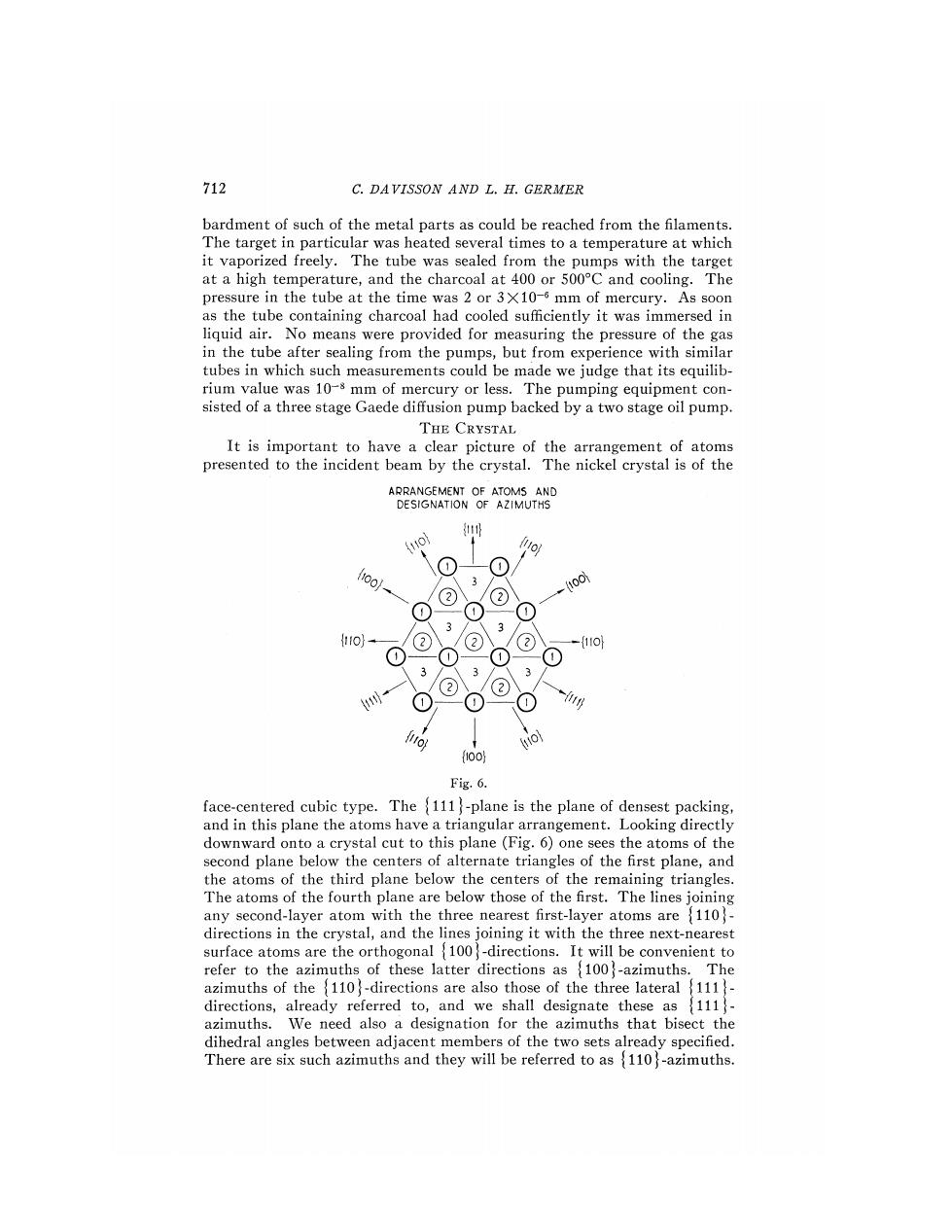
712 C.DAVISSON AND L.H.GERMER bardment of such of the metal parts as could be reached from the filaments. The target in particular was heated several times to a temperature at which it vaporized freely.The tube was sealed from the pumps with the target at a high temperature,and the charcoal at 400 or 500C and cooling.The pressure in the tube at the time was 2 or 3X10-6 mm of mercury.As soon as the tube containing charcoal had cooled sufficiently it was immersed in liquid air.No means were provided for measuring the pressure of the gas in the tube after sealing from the pumps,but from experience with similar tubes in which such measurements could be made we judge that its equilib- rium value was 10-s mm of mercury or less.The pumping equipment con- sisted of a three stage Gaede diffusion pump backed by a two stage oil pump. THE CRYSTAL It is important to have a clear picture of the arrangement of atoms presented to the incident beam by the crystal.The nickel crystal is of the ARRANGEMENT OF ATOMS AND DESIGNATION OF AZIMUTHS 1t业 (HO) (oo]- ① 00 ② ① ① ① 3 o}→ ② -{11o ① -① ① 3 3 3 tW- ② ② ① ⊙ ⑦ firo tio {I00 Fig.6. face-centered cubic type.The 111-plane is the plane of densest packing, and in this plane the atoms have a triangular arrangement.Looking directly downward onto a crystal cut to this plane(Fig.6)one sees the atoms of the second plane below the centers of alternate triangles of the first plane,and the atoms of the third plane below the centers of the remaining triangles The atoms of the fourth plane are below those of the first.The lines joining any second-layer atom with the three nearest first-layer atoms are 110- directions in the crystal,and the lines joining it with the three next-nearest surface atoms are the orthogonal100-directions.It will be convenient to refer to the azimuths of these latter directions as 100-azimuths.The azimuths of the 110-directions are also those of the three lateral 111- directions,already referred to,and we shall designate these as (111- azimuths.We need also a designation for the azimuths that bisect the dihedral angles between adjacent members of the two sets already specified. There are six such azimuths and they will be referred to as110-azimuths
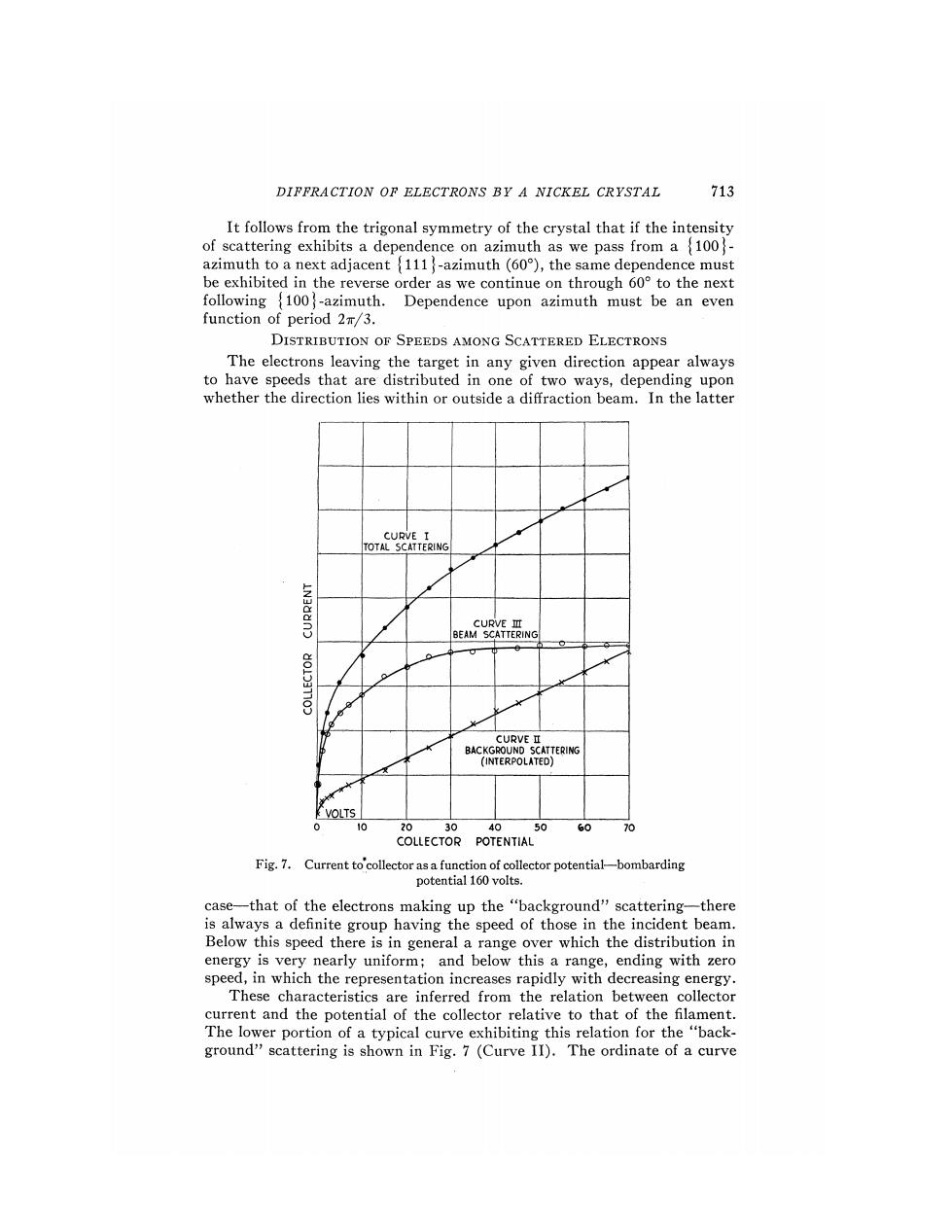
DIFFRACTION OF ELECTRONS BY A NICKEL CRYSTAL 713 It follows from the trigonal symmetry of the crystal that if the intensity of scattering exhibits a dependence on azimuth as we pass from a 100- azimuth to a next adjacent 111-azimuth(60),the same dependence must be exhibited in the reverse order as we continue on through 60 to the next following 100-azimuth.Dependence upon azimuth must be an even function of period 27/3. DISTRIBUTION OF SPEEDS AMONG SCATTERED ELECTRONS The electrons leaving the target in any given direction appear always to have speeds that are distributed in one of two ways,depending upon whether the direction lies within or outside a diffraction beam.In the latter CURVE I TOTAL SCATTERING CURVE I BEAM SCATTERING CURVEΠ BACKGROUND SCATTERING (INTERPOLATED) VOLTS 0 10 20 30 40 50 6070 COLLECTOR POTENTIAL Fig.7.Current to collector as a function of collector potential-bombarding potential 160 volts case-that of the electrons making up the "background"scattering-there is always a definite group having the speed of those in the incident beam. Below this speed there is in general a range over which the distribution in energy is very nearly uniform;and below this a range,ending with zero speed,in which the representation increases rapidly with decreasing energy. These characteristics are inferred from the relation between collector current and the potential of the collector relative to that of the filament. The lower portion of a typical curve exhibiting this relation for the "back- ground"scattering is shown in Fig.7(Curve II).The ordinate of a curve
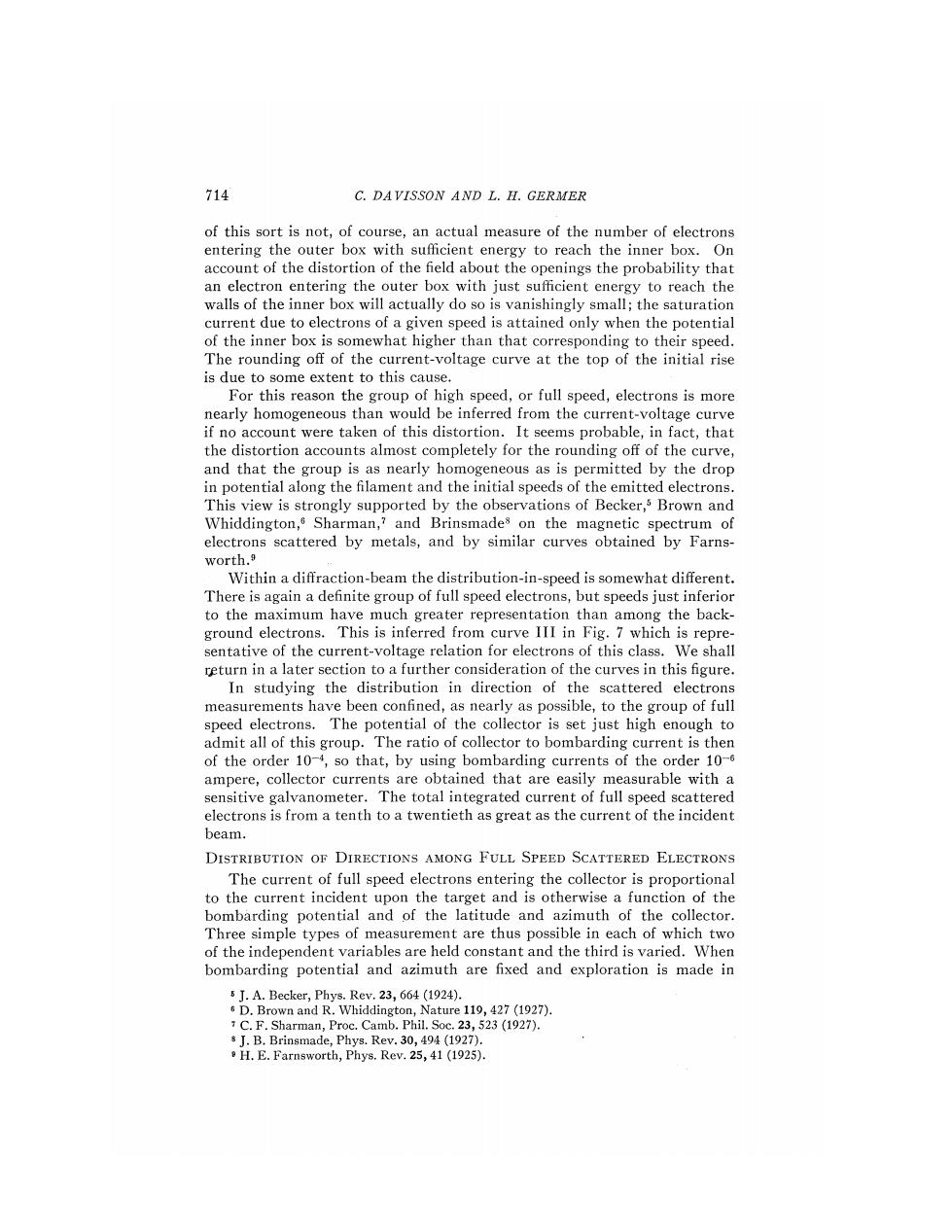
714 C.DAVISSON AND L.H.GERMER of this sort is not,of course,an actual measure of the number of electrons entering the outer box with sufficient energy to reach the inner box.On account of the distortion of the field about the openings the probability that an electron entering the outer box with just sufficient energy to reach the walls of the inner box will actually do so is vanishingly small;the saturation current due to electrons of a given speed is attained only when the potential of the inner box is somewhat higher than that corresponding to their speed. The rounding off of the current-voltage curve at the top of the initial rise is due to some extent to this cause. For this reason the group of high speed,or full speed,electrons is more nearly homogeneous than would be inferred from the current-voltage curve if no account were taken of this distortion.It seems probable,in fact,that the distortion accounts almost completely for the rounding off of the curve, and that the group is as nearly homogeneous as is permitted by the drop in potential along the filament and the initial speeds of the emitted electrons. This view is strongly supported by the observations of Becker,5 Brown and Whiddington,Sharman,?and Brinsmades on the magnetic spectrum of electrons scattered by metals,and by similar curves obtained by Farns- worth.9 Within a diffraction-beam the distribution-in-speed is somewhat different. There is again a definite group of full speed electrons,but speeds just inferior to the maximum have much greater representation than among the back- ground electrons.This is inferred from curve III in Fig.7 which is repre- sentative of the current-voltage relation for electrons of this class.We shall return in a later section to a further consideration of the curves in this figure. In studying the distribution in direction of the scattered electrons measurements have been confined,as nearly as possible,to the group of full speed electrons.The potential of the collector is set just high enough to admit all of this group.The ratio of collector to bombarding current is then of the order 10-4,so that,by using bombarding currents of the order 10-6 ampere,collector currents are obtained that are easily measurable with a sensitive galvanometer.The total integrated current of full speed scattered electrons is from a tenth to a twentieth as great as the current of the incident beam. DISTRIBUTION OF DIRECTIONS AMONG FULL SPEED SCATTERED ELECTRONS The current of full speed electrons entering the collector is proportional to the current incident upon the target and is otherwise a function of the bombarding potential and of the latitude and azimuth of the collector. Three simple types of measurement are thus possible in each of which two of the independent variables are held constant and the third is varied.When bombarding potential and azimuth are fixed and exploration is made in 5 J.A.Becker,Phys.Rev.23,664 (1924). D.Brown and R.Whiddington,Nature 119,427 (1927). C.F.Sharman,Proc.Camb.Phil.Soc.23,523(1927). s J.B.Brinsmade,Phys.Rev.30,494 (1927). H.E.Farnsworth,Phys.Rev.25,41 (1925)